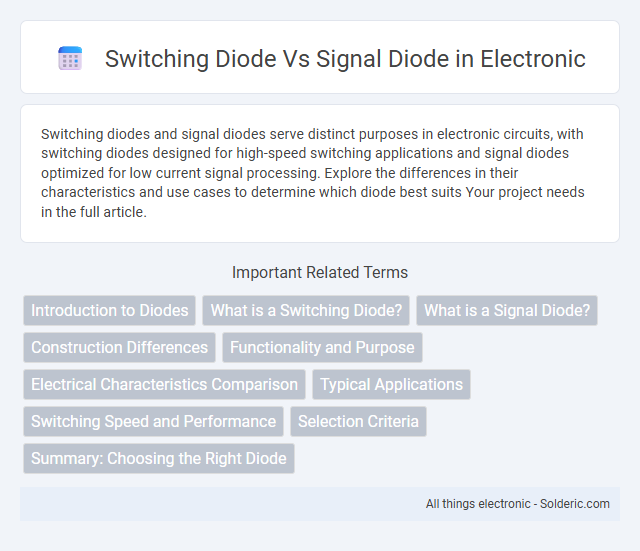Switching diodes and signal diodes serve distinct purposes in electronic circuits, with switching diodes designed for high-speed switching applications and signal diodes optimized for low current signal processing. Explore the differences in their characteristics and use cases to determine which diode best suits Your project needs in the full article.
Comparison Table
| Feature | Switching Diode | Signal Diode |
|---|---|---|
| Purpose | Fast switching applications | Low current signal processing |
| Switching Speed | Nanoseconds range (fast response) | Slower compared to switching diodes |
| Frequency | High-frequency circuits | Low to medium frequency |
| Current Rating | Typically low to moderate | Very low currents |
| Reverse Recovery Time | Very short (few nanoseconds) | Longer recovery time |
| Examples | 1N4148, 1N4149 | 1N914, 1N3581 |
| Applications | Pulse circuits, digital logic, RF switching | Signal demodulation, switching low-level signals |
Introduction to Diodes
Switching diodes and signal diodes are essential semiconductor devices designed to control current flow in electronic circuits. Switching diodes excel in fast switching applications due to their low junction capacitance and rapid recovery time, making them ideal for high-speed digital circuits. Signal diodes, optimized for low current and high-frequency applications, provide precise signal rectification and protection in communication and audio devices, ensuring your circuit's reliable performance.
What is a Switching Diode?
A switching diode is a semiconductor device designed to switch between its conducting and non-conducting states rapidly, making it ideal for high-speed signal processing and digital circuits. Unlike signal diodes optimized for low-current, high-frequency signals, switching diodes handle faster transitions due to their low recovery time and minimal junction capacitance. Common examples include the 1N4148 diode, widely used in switching applications for efficient, reliable performance.
What is a Signal Diode?
A signal diode is a semiconductor device designed to handle low current and high-frequency signals, commonly used in electronic circuits for switching and rectification. Unlike switching diodes, which are optimized for fast switching speeds to control power flow, signal diodes prioritize minimal capacitance and low forward voltage drop to efficiently transmit small signals. These characteristics make signal diodes ideal for applications in radios, amplifiers, and detection circuits where precision and speed are critical.
Construction Differences
Switching diodes are designed with fast recovery times and low junction capacitance, typically featuring a smaller junction area to enhance switching speed. Signal diodes, on the other hand, have larger junction volumes to handle low current and voltage signals with minimal distortion, emphasizing sensitivity rather than speed. Understanding these construction differences helps you select the appropriate diode for high-speed switching or precise signal detection applications.
Functionality and Purpose
Switching diodes are designed primarily for high-speed switching applications, enabling rapid transition between on and off states in electronic circuits. Signal diodes, optimized for low current and high-frequency signal processing, are used to rectify, clip, or demodulate signals in communication devices. Both types exhibit fast recovery times, but switching diodes prioritize switching speed, while signal diodes focus on signal integrity and minimal distortion.
Electrical Characteristics Comparison
Switching diodes typically have faster recovery times and higher reverse recovery speeds than signal diodes, making them ideal for high-frequency switching applications. Signal diodes feature lower forward voltage drops and are optimized for low current, low voltage tasks such as signal detection and small-signal rectification. Your choice between the two should depend on the operating frequency, voltage, and current requirements of your electronic circuit.
Typical Applications
Switching diodes are commonly used in high-speed switching circuits, digital logic gates, and signal demodulation due to their fast recovery time and low forward voltage drop. Signal diodes find typical applications in small signal rectification, clipping, clamping circuits, and voltage regulation because of their ability to handle low current and high-frequency signals efficiently. Your choice between switching and signal diodes depends on the specific electronic circuit requirements, such as switching speed and signal integrity.
Switching Speed and Performance
Switching diodes feature ultra-fast switching speeds typically in the nanosecond range, making them ideal for high-frequency applications and rapid signal modulation. Signal diodes, while versatile for general-purpose signal rectification, operate at slower switching speeds, often in the microsecond range, limiting their performance in high-speed circuits. For optimizing Your circuit's responsiveness and minimizing signal distortion, switching diodes provide superior performance due to their low recovery time and high-frequency efficiency.
Selection Criteria
Selection criteria for switching diodes versus signal diodes emphasize their intended application and electrical characteristics. Switching diodes are chosen for high-speed switching capabilities, low forward voltage drop, and high reverse recovery speed, making them ideal for digital circuits and high-frequency environments. Signal diodes prioritize low capacitance, low leakage current, and high sensitivity to small signals, suitable for signal detection and low-level signal processing.
Summary: Choosing the Right Diode
Switching diodes excel in high-speed switching applications due to their fast recovery time and low junction capacitance, making them ideal for digital circuits and signal routing. Signal diodes, designed for low current and voltage applications, offer efficient signal demodulation and general-purpose rectification with minimal signal distortion. Selecting the right diode depends on factors like switching speed, voltage rating, and application-specific requirements, ensuring optimal circuit performance.
Switching Diode vs Signal Diode Infographic

 solderic.com
solderic.com